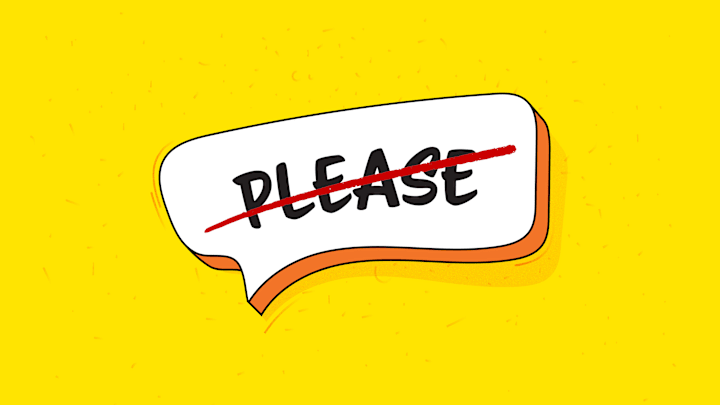When travelers heading to other countries want to learn some local words to make sure they have a stress-free time, please is probably near the top of the list. Spanish has por favor, German has bitte, and French has s’il vous plaît. But it's trickier for those visiting visiting Scandinavia (or more generally, the Nordic countries): In Norway, Sweden, Denmark, Iceland, and Finland, please isn’t part of the vocabulary like it is in English. Without it, how do you get along?
Directness as a Virtue
Scandinavians often appreciate more direct, factual communication and may simply dispense with pleasantries, especially when speaking with people they’ve met before. Scandinavian countries also tend to be pretty egalitarian; you’re not often expected to show deference. Still, people in Scandinavia are actually plenty courteous with one another—it’s just expressed in a more roundabout way.

Being casual can actually be a term of endearment among Scandinavians. You could ask “Would you be so kind as to buy me a coffee?,” but it’s actually a sign of a stronger relationship to just smile and say, “Buy me a coffee?” Too much politeness risks implying that you’re not very close, as you’d be more likely to use formal words with strangers. Going overboard on politeness could also imply that you’re asking someone to do you a huge favor, rather than asking someone do something like pass the salt, where the word please is implied with tone.
You Might Also Like ...
- In Norway, Texas Is Slang for “Crazy”
- How Swedish Students Let Off Steam—By Screaming in Public
- 11 Delightful Icelandic Words and Phrases
Add Mental Floss as a preferred news source!
How to be Polite in Scandinavia

But there are definitely times when Scandinavians want a word to express gratitude, or to stress politeness in asking for something. Here are some examples of how to say “please” in the roundabout way Scandinavians do. (Note: None of these words perfectly match-up with the English please. Snälla, for instance, is usually considered to have more of a pleading or even passive aggressive tone than English please.)
Norwegian // Vennligst
Meaning: “Most friendly” (literal) / “kindly” (implied)
- Kan jeg vennligst be deg senke stemmen? (“May I kindly ask you to lower your voice?”)
Norwegian // Gjerne
Meaning: “Gladly,” “readily” (literal) / “If you will” (implied)
- Vil du ha vafler? (“Do you want waffles?”) / “Ja, gjerne. (“Yes, gladly.”)
- Plukk gjerne opp etter dere. (“Pick up after yourselves, if you will.”) / Det gjør vi gjerne. (“We’ll do that gladly.”)
Swedish // Snälla
Meaning: “Kindly”
- Skulle du ge mig syltburken, snälla? (“Could you pass me the jam, kindly?”)
Icelandic // Takk
Meaning: “Thank you”
- Já, takk! (“Yes, thank you!”)
Danish // Værsgo
Meaning: “Be so good” (literal) / “Here you are” (implied) / “You’re welcome” (implied)
- Værsgo at tage plads i venteværelset (“Be so good and take a seat in the waiting room”)
- Tak! (“Thank you!”) / Answer: Værsgo! (“You’re welcome!”)
Finnish // Kiitos
Meaning: “Thanks”
- Haluaisitko lisää viiniä? (“Would you like some more wine?”) / Ei kiitos. (“No, thank you.”)
- Kiitos. (“Thanks.”) / Ole hyvä. (“You’re welcome.”)
Say “Thanks,” or Just Smile
A decent shortcut for visitors wishing to be polite in Scandinavia is to throw in a few “thanks” where you feel a little something is required. That’s takk in Norwegian and Icelandic, tack in Swedish, and tak in Danish, all pronounced with the same snappy “takk.” In Finnish it’s kiitos, pronounced “KEE-tohs.”
Be aware, though, that the risk is in overdoing it: You’d probably want to say “ja takk” (“yes, thank you”) if someone asks you if you’d like a drink, but if you use too many of these please replacement words, it can start to feel a bit cloying and disingenuous.
Because so much of the meaning of please lies in the attitude of the speaker, you can also skip these formalities and just speak plainly. As long as the question starts with a conditional phrase (like would you or may I), it’s usually considered polite enough, assuming it’s delivered with a friendly expression.
In many languages, please really is the magic word. But in Norway, Sweden, Denmark, Iceland, and Finland, it’s often just verbal clutter—expressing politeness is all in the delivery, your body language, and the look on your face. And if that sounds tricky, spare a thought for the Scandinavians as they venture out to other countries where there’s most definitely a word for “please” and you’re expected to use it—and no friendly expression will come close to compensating when you forget.
